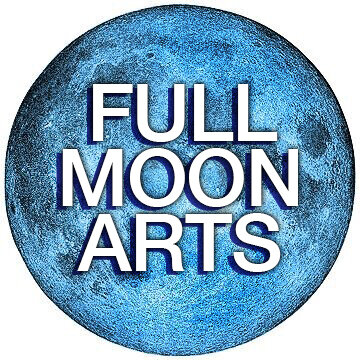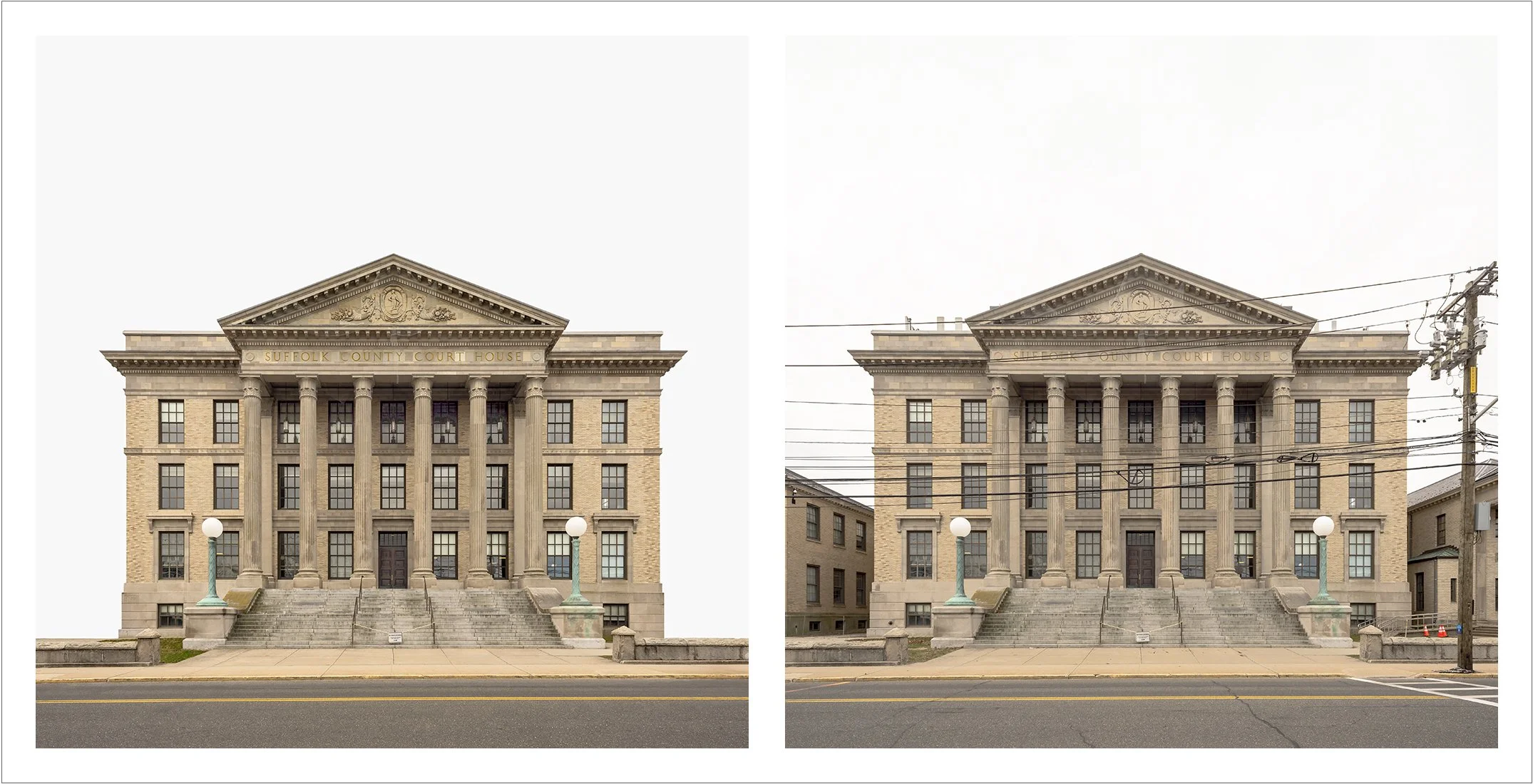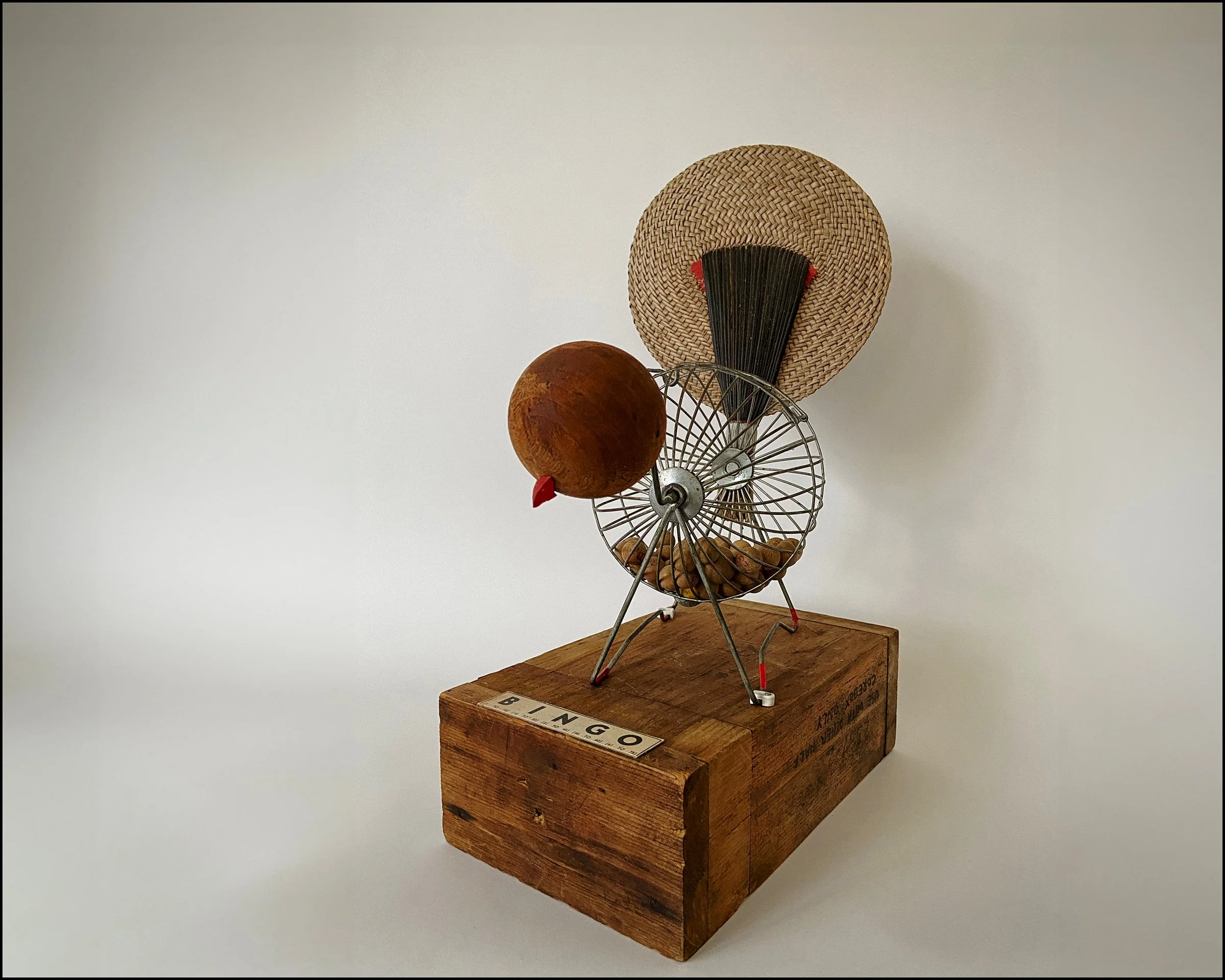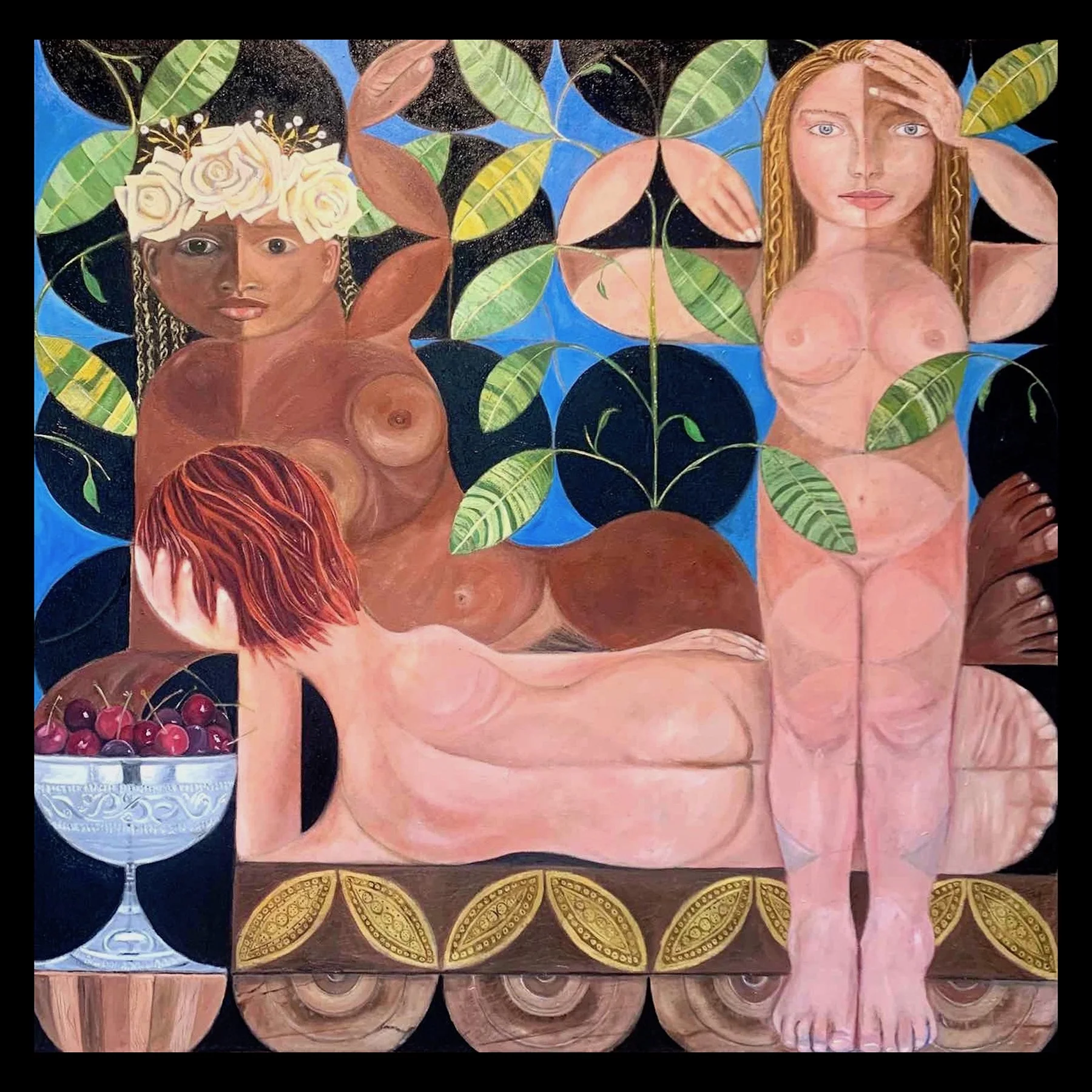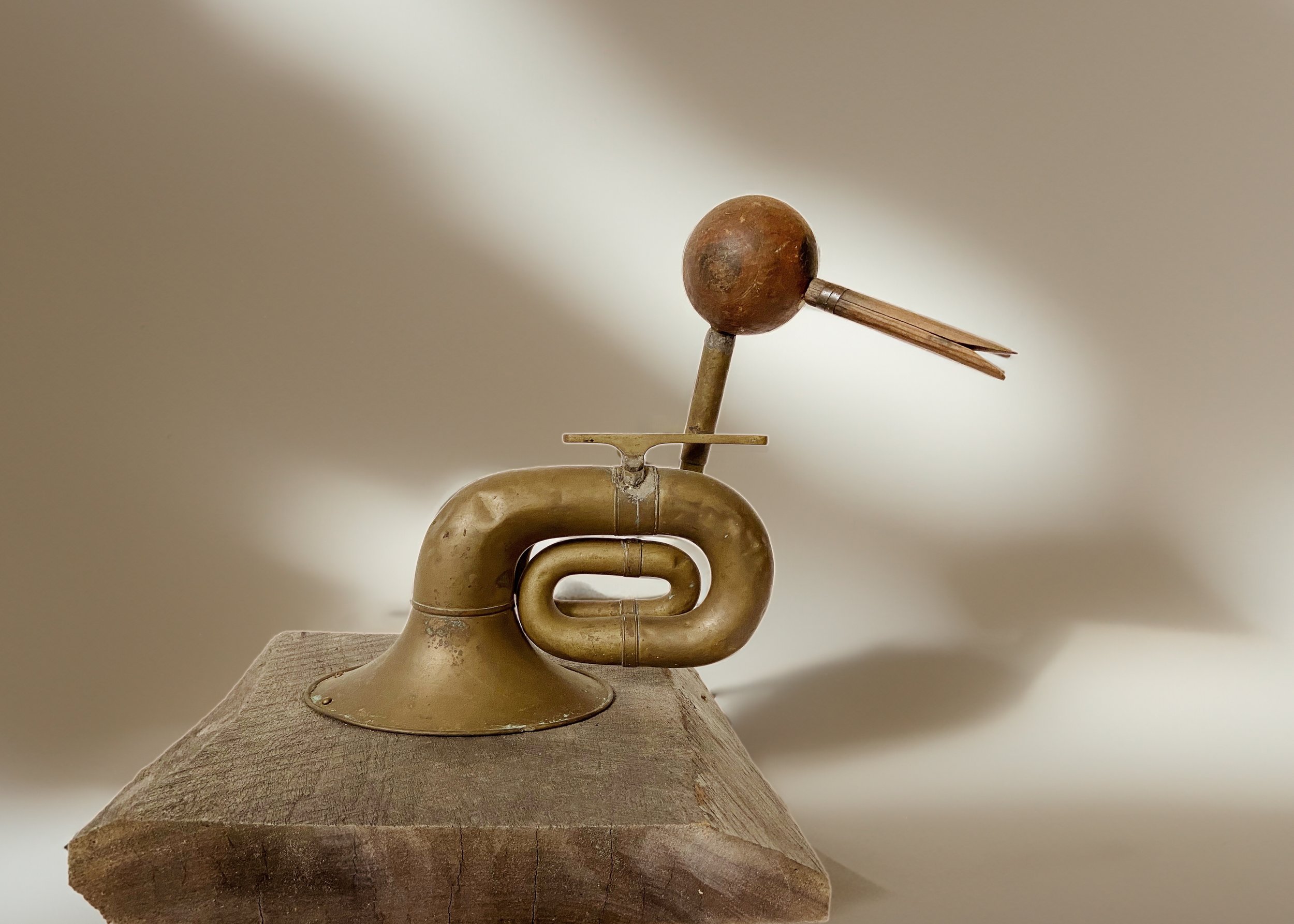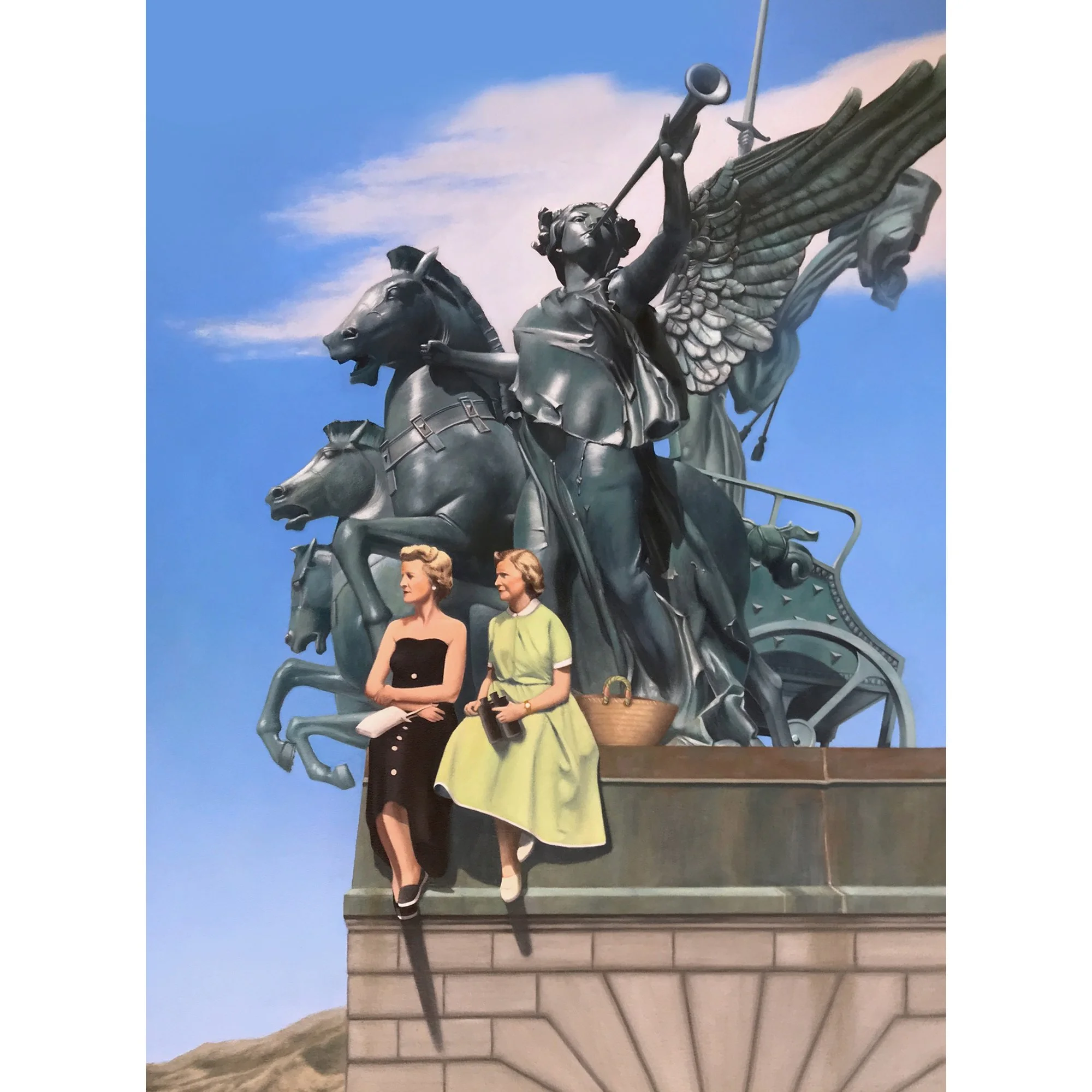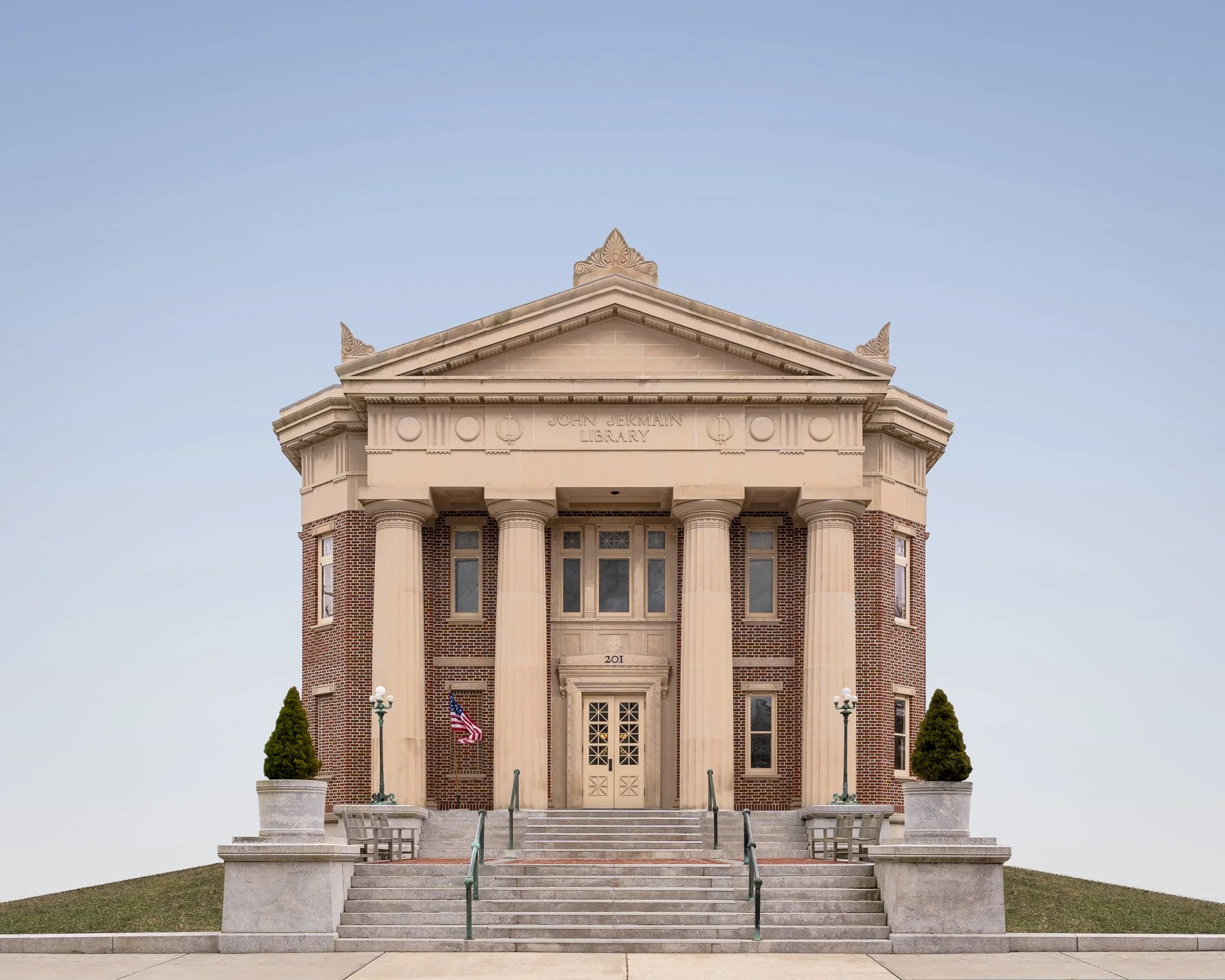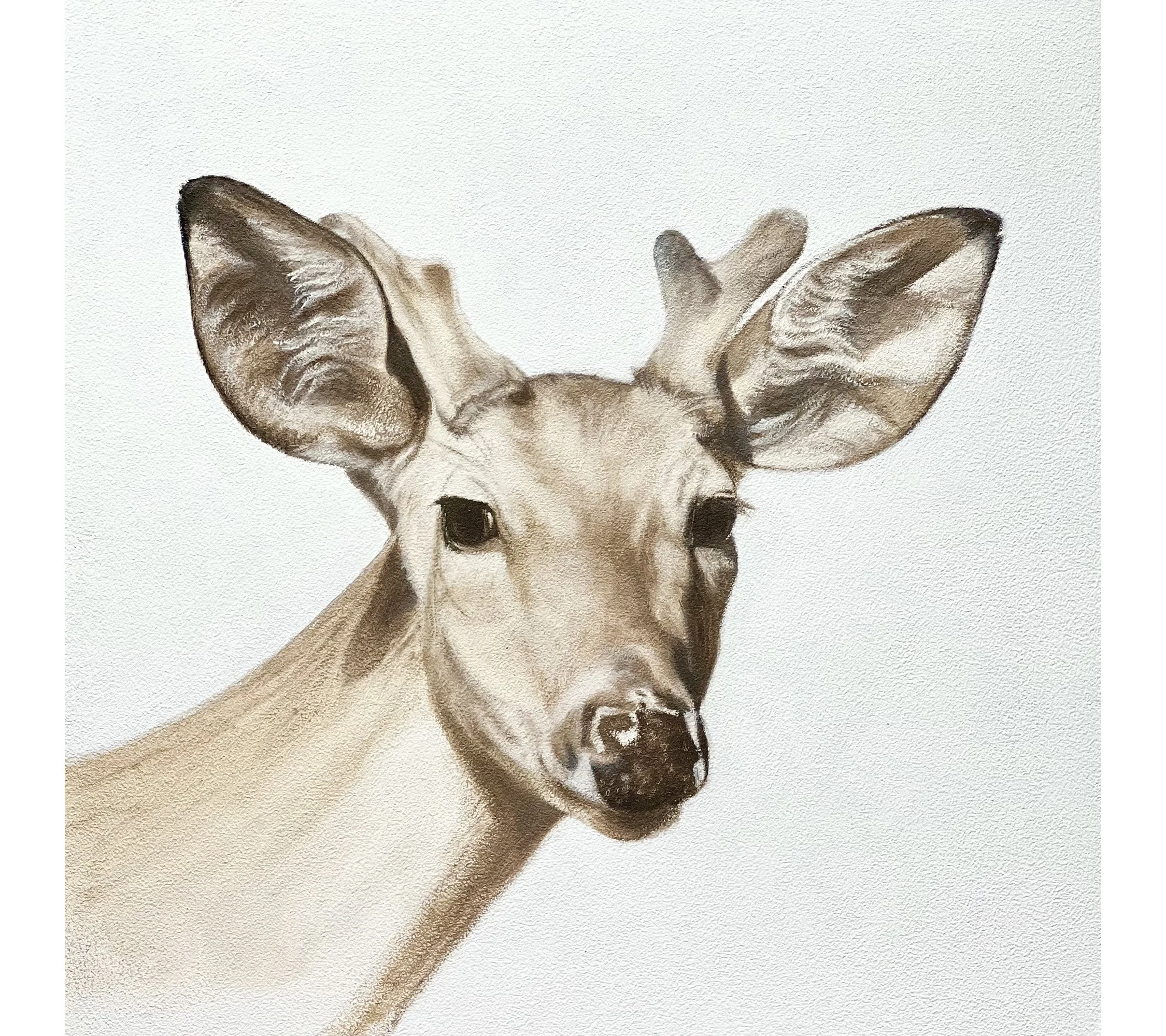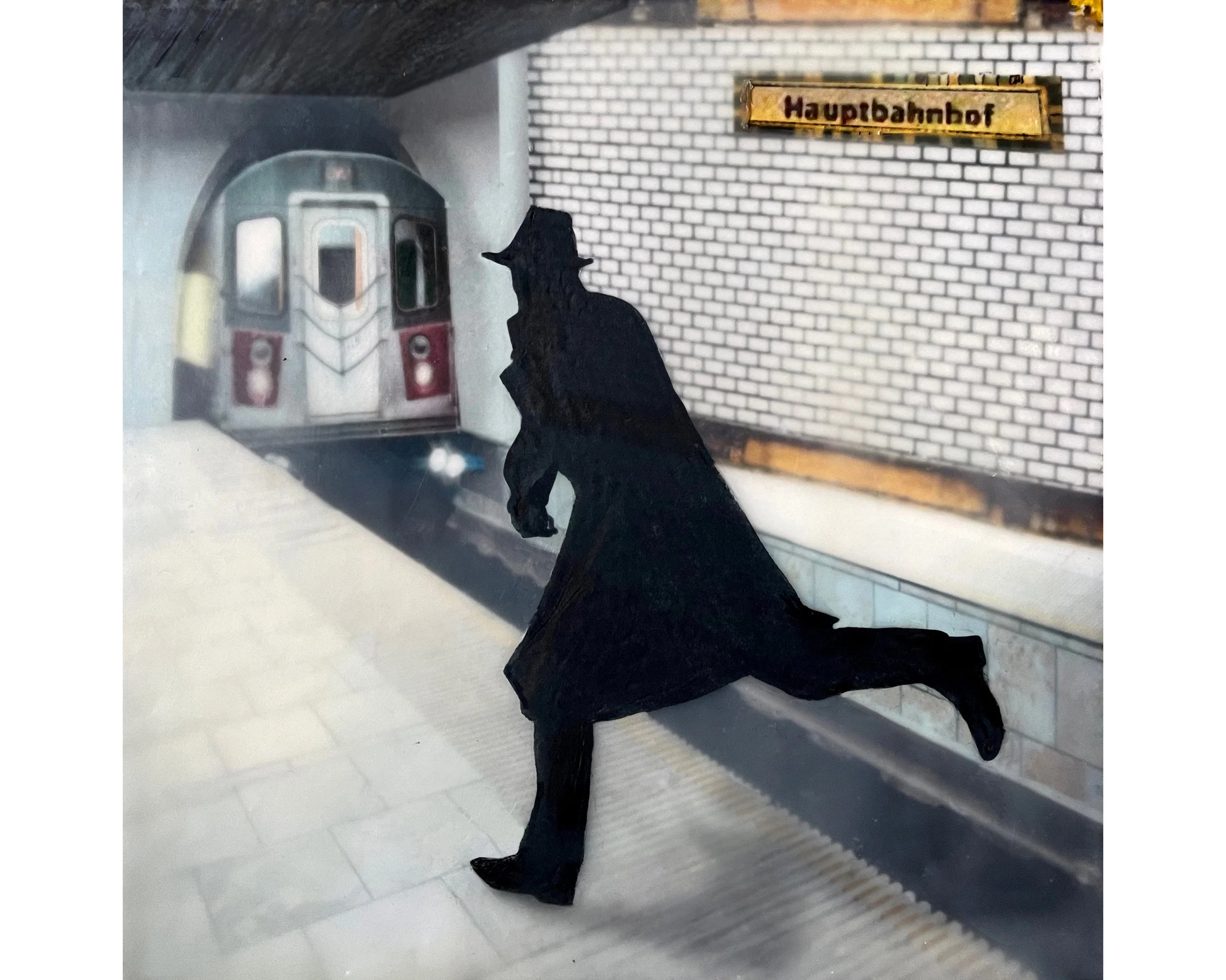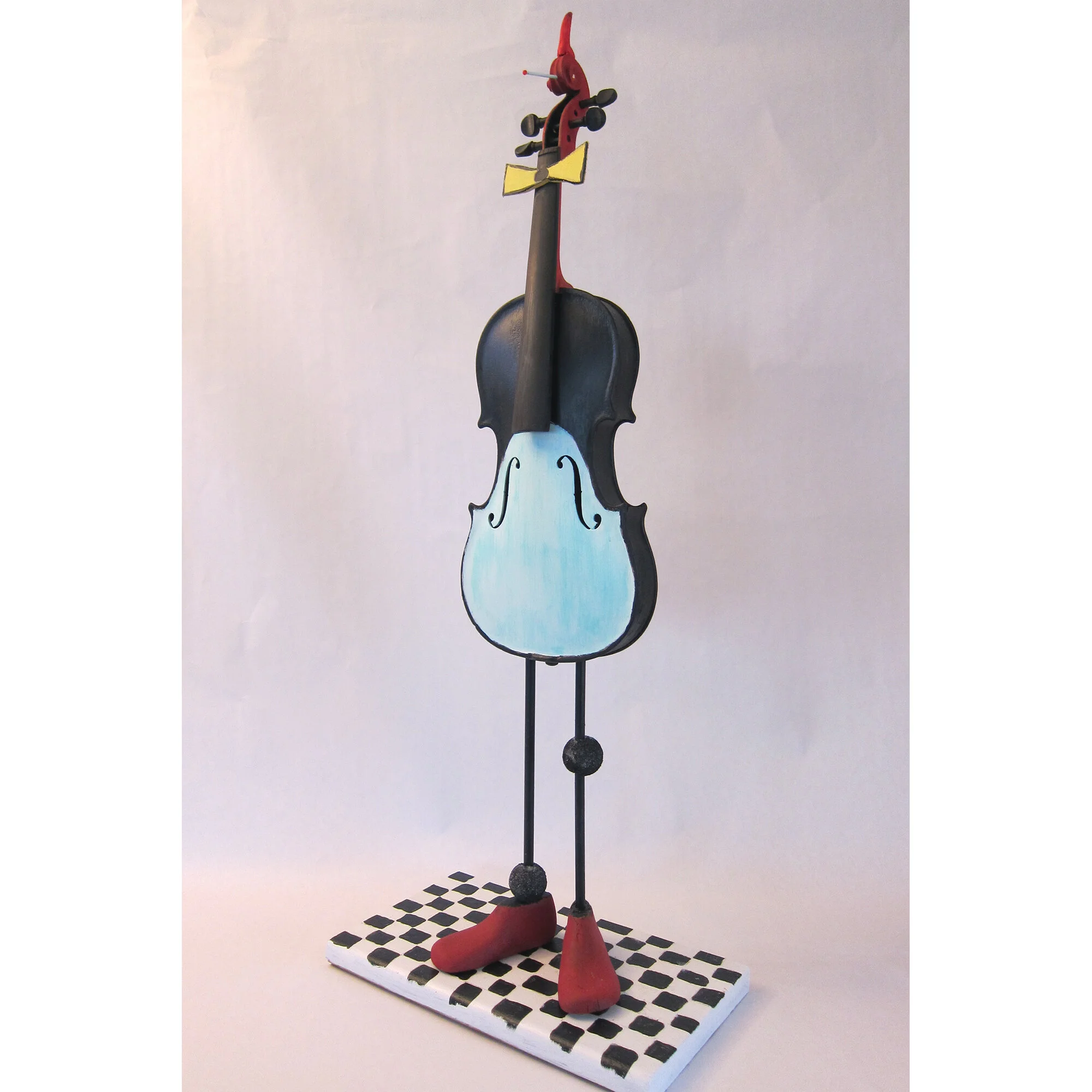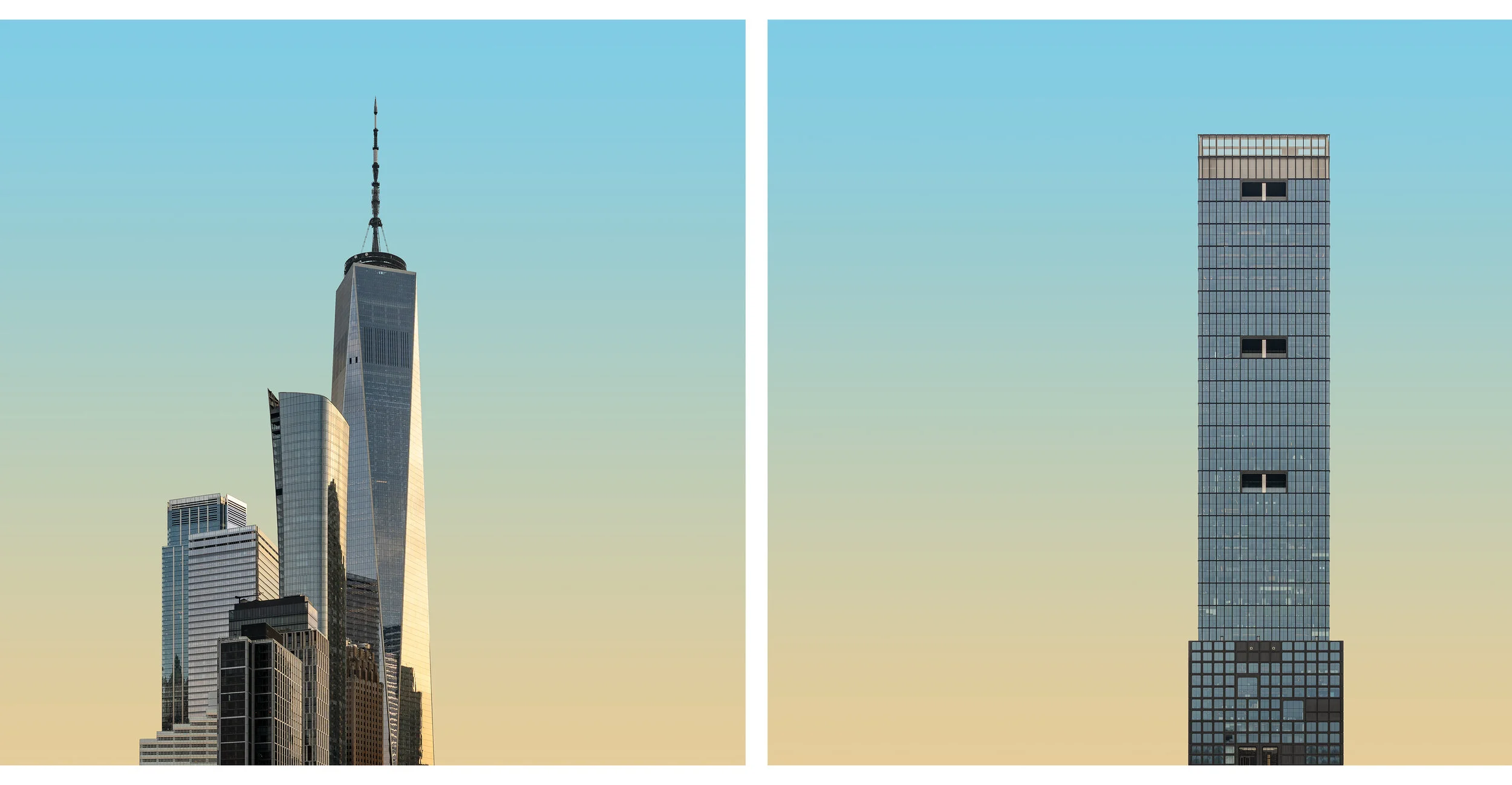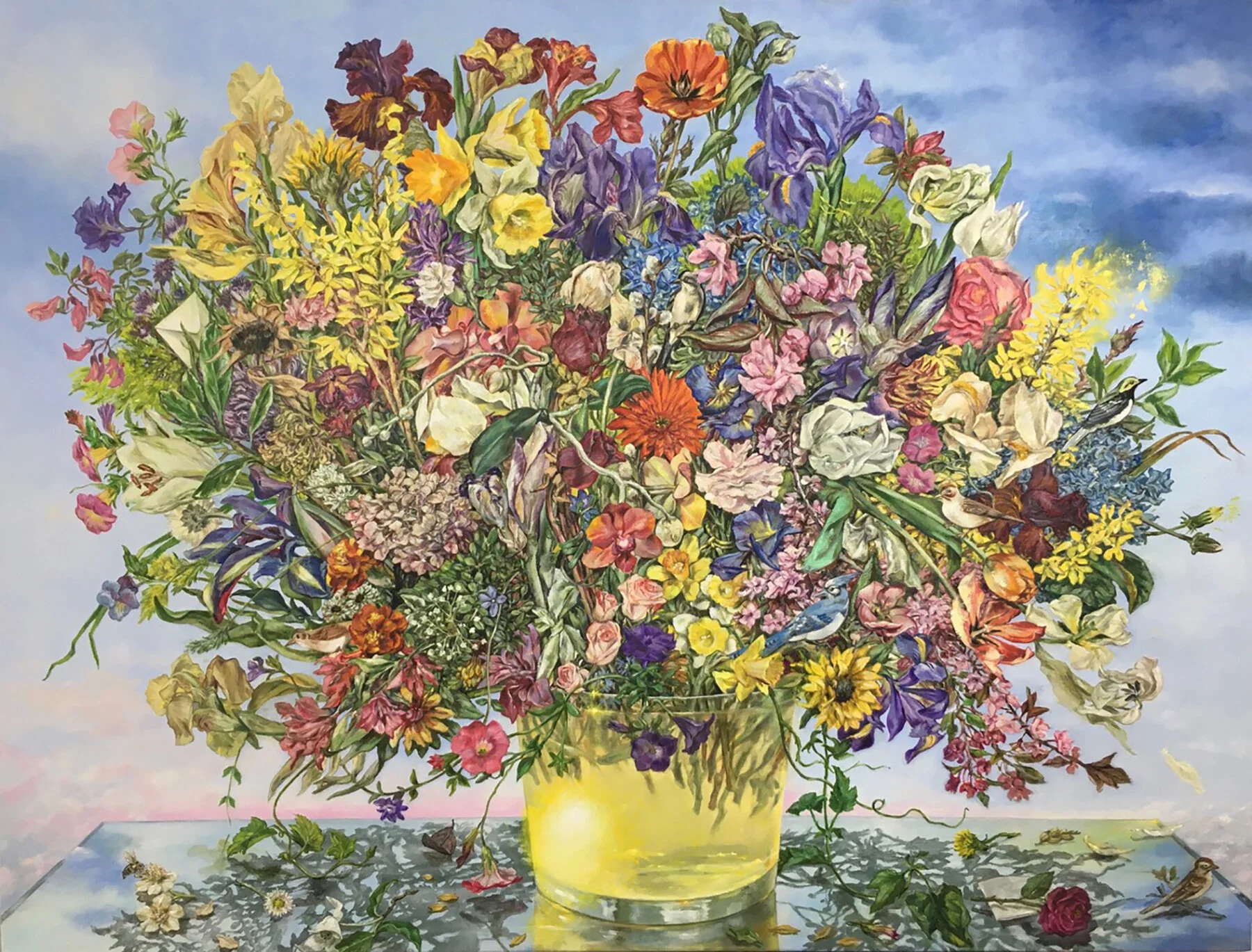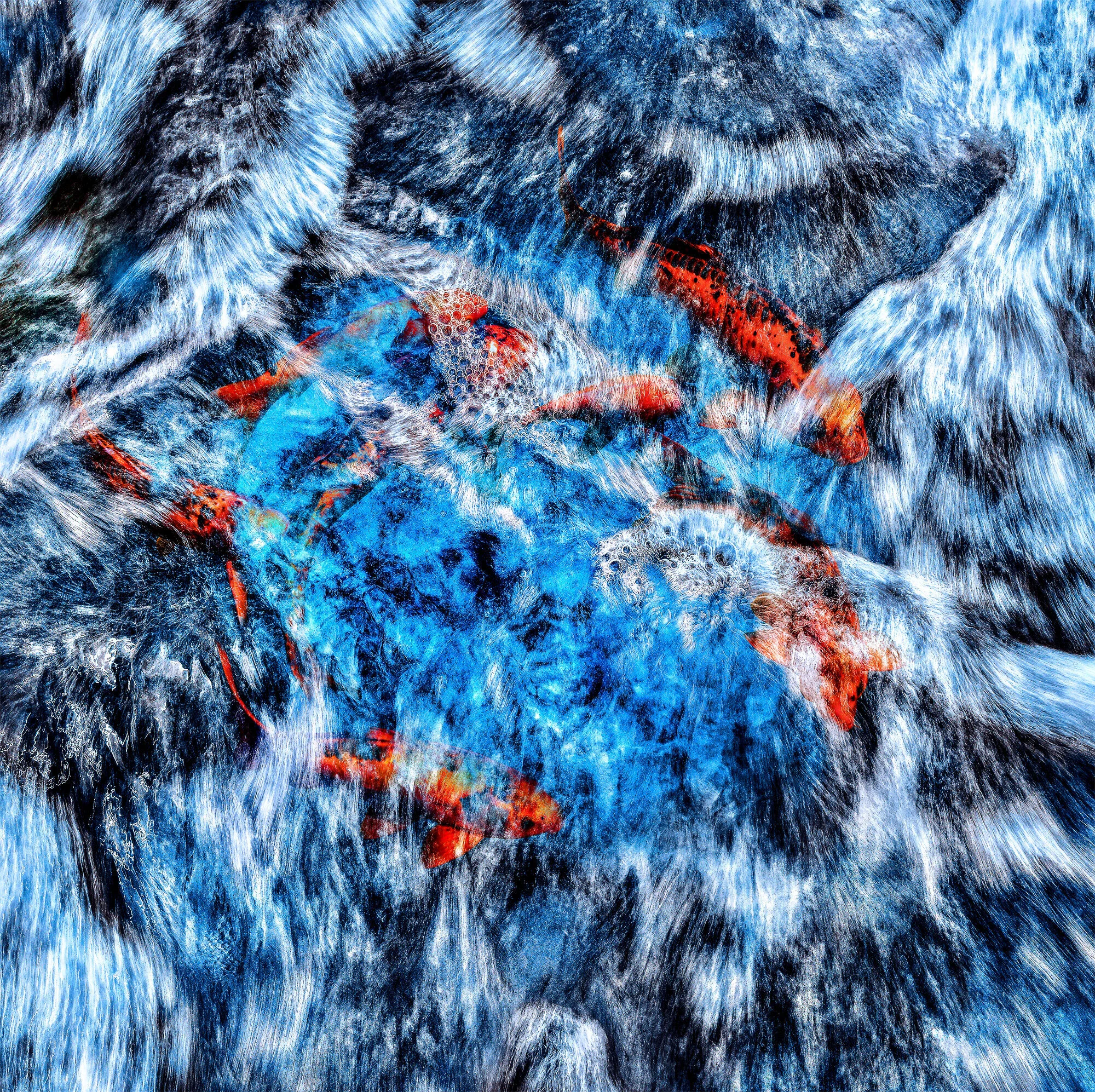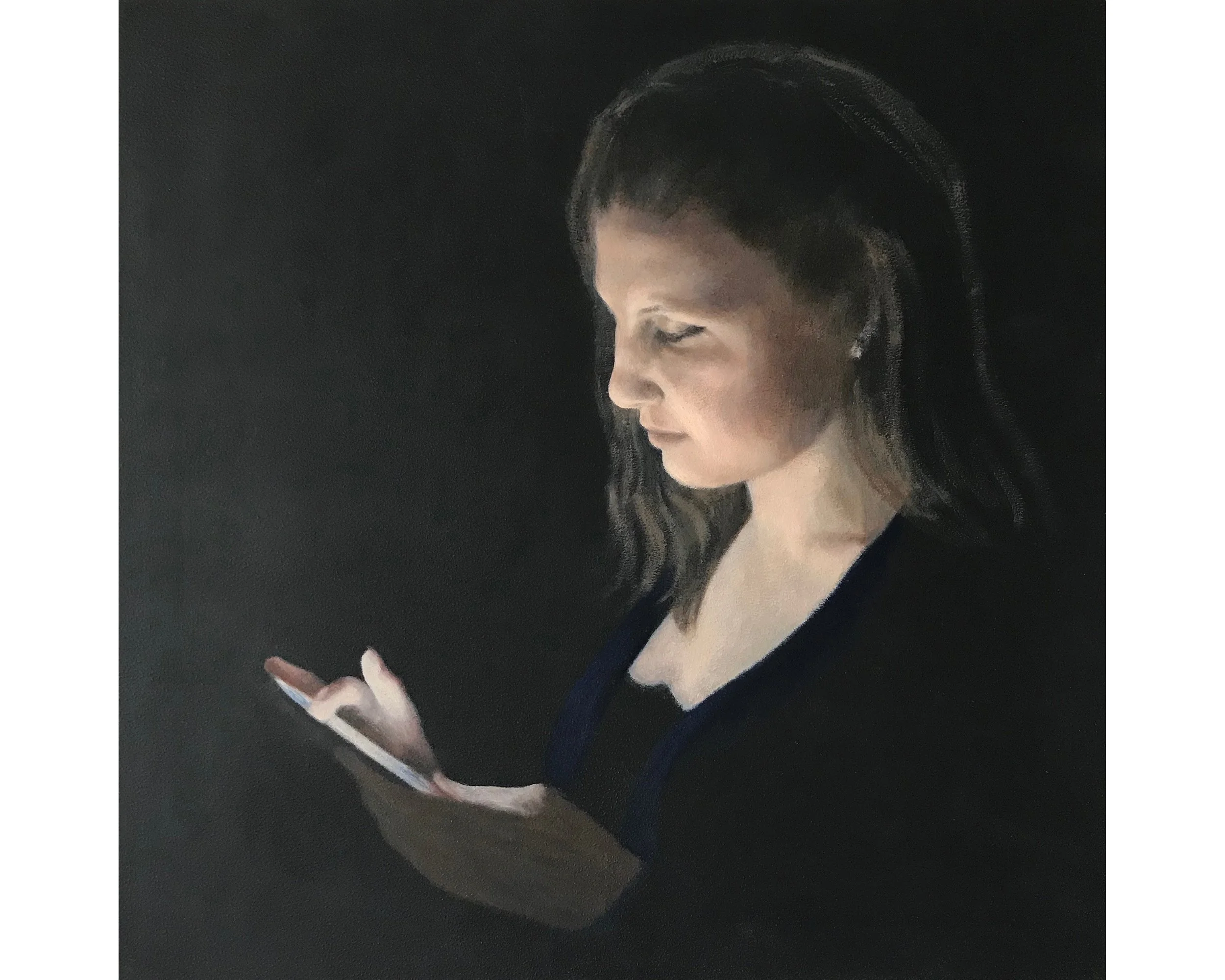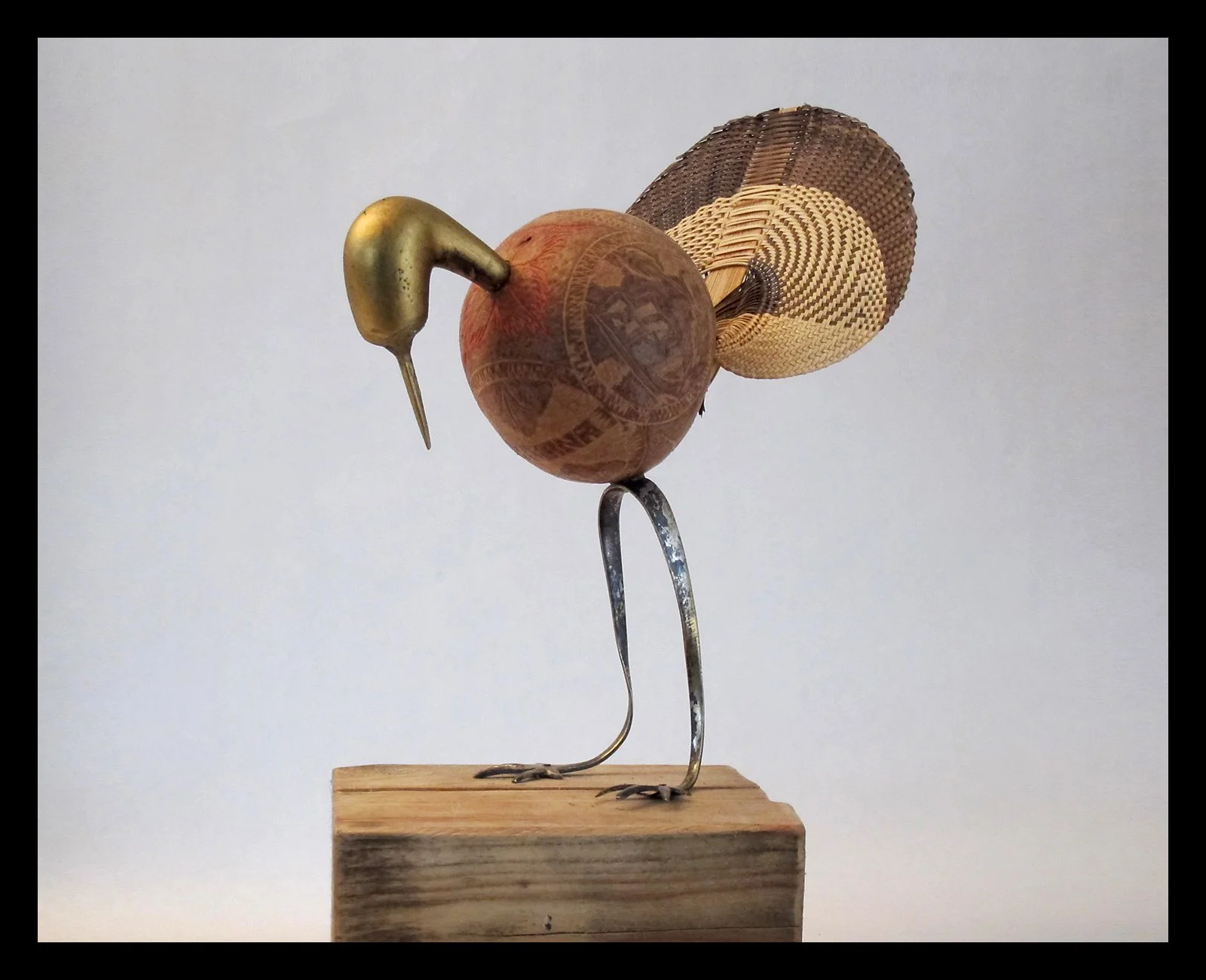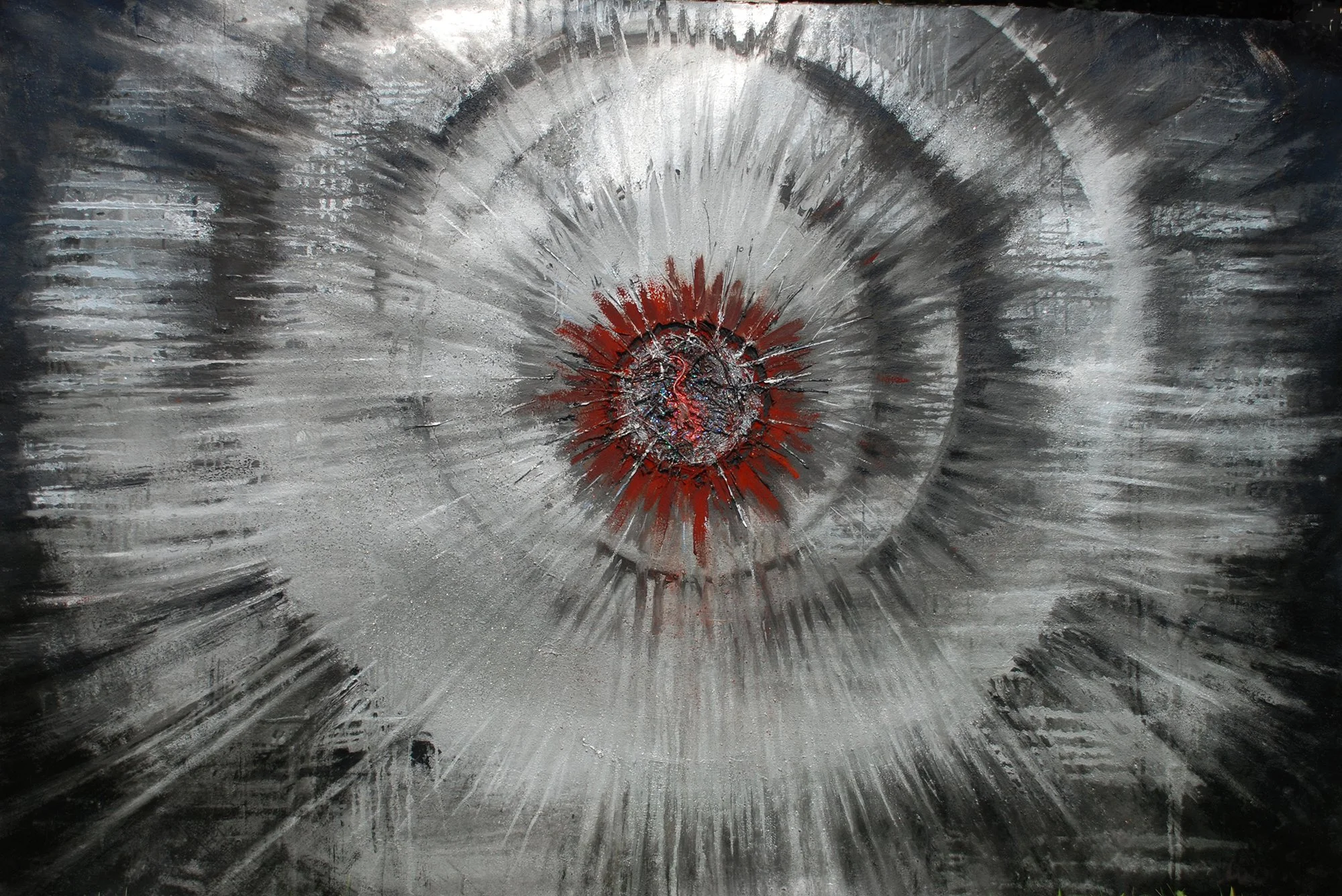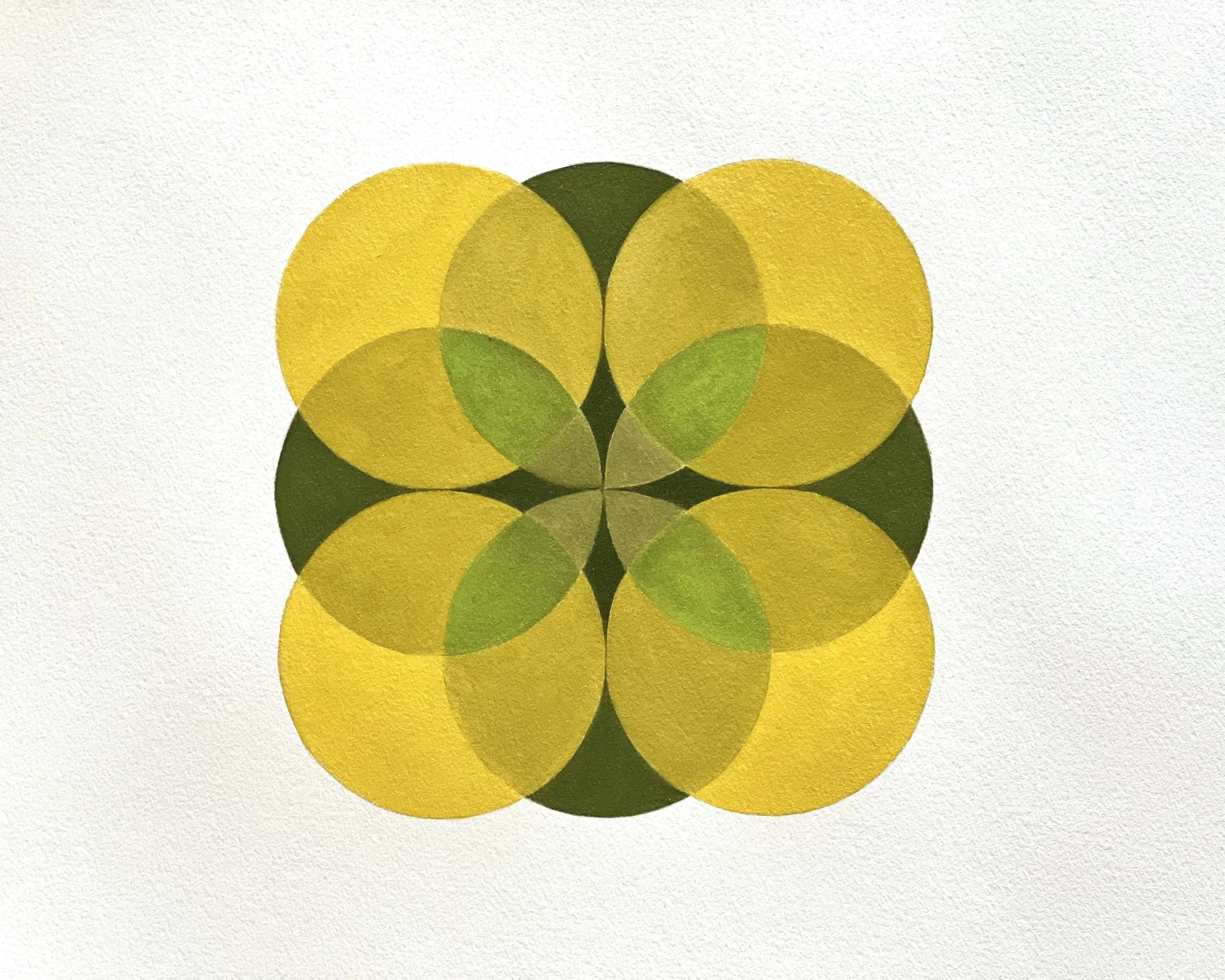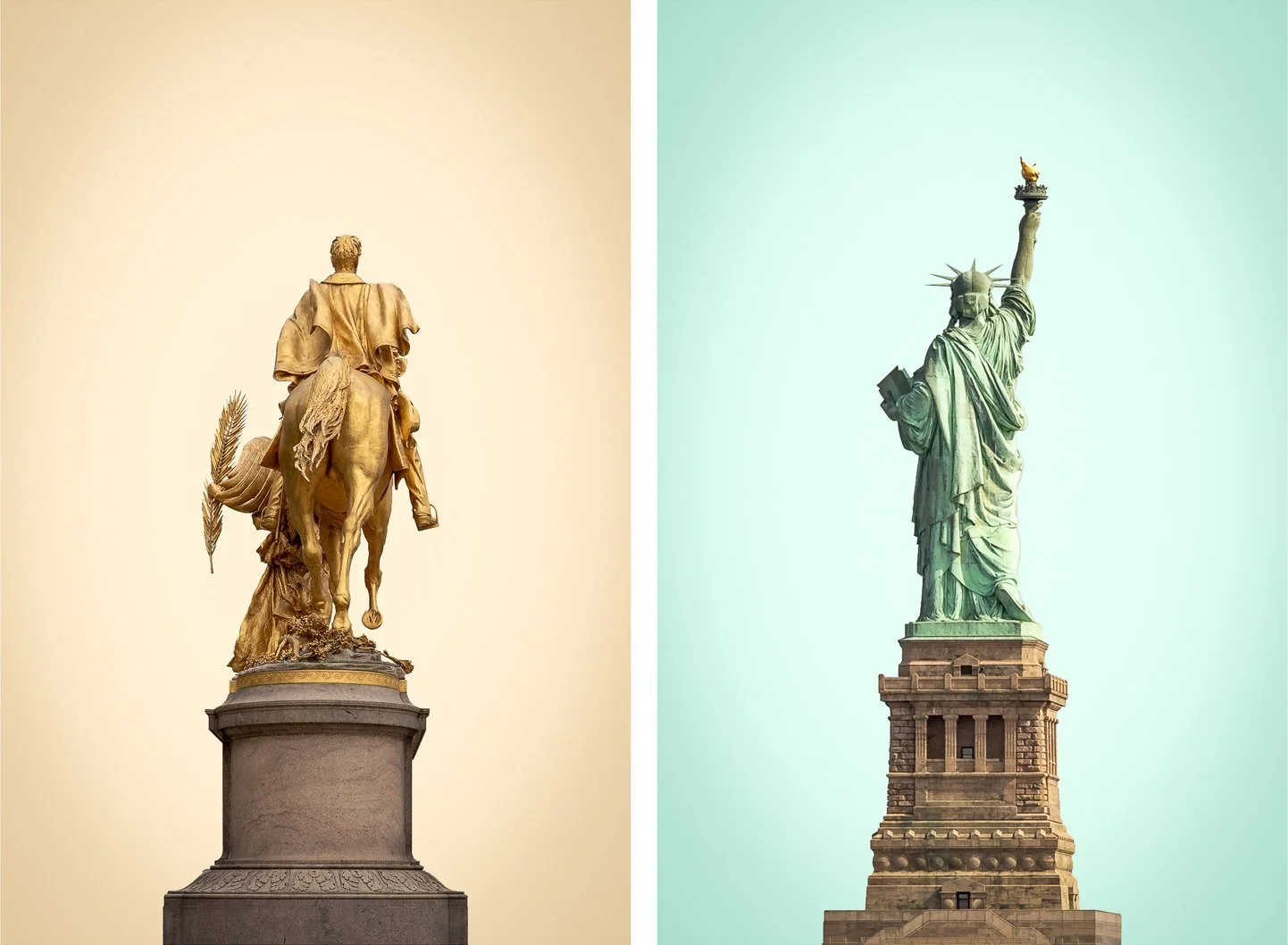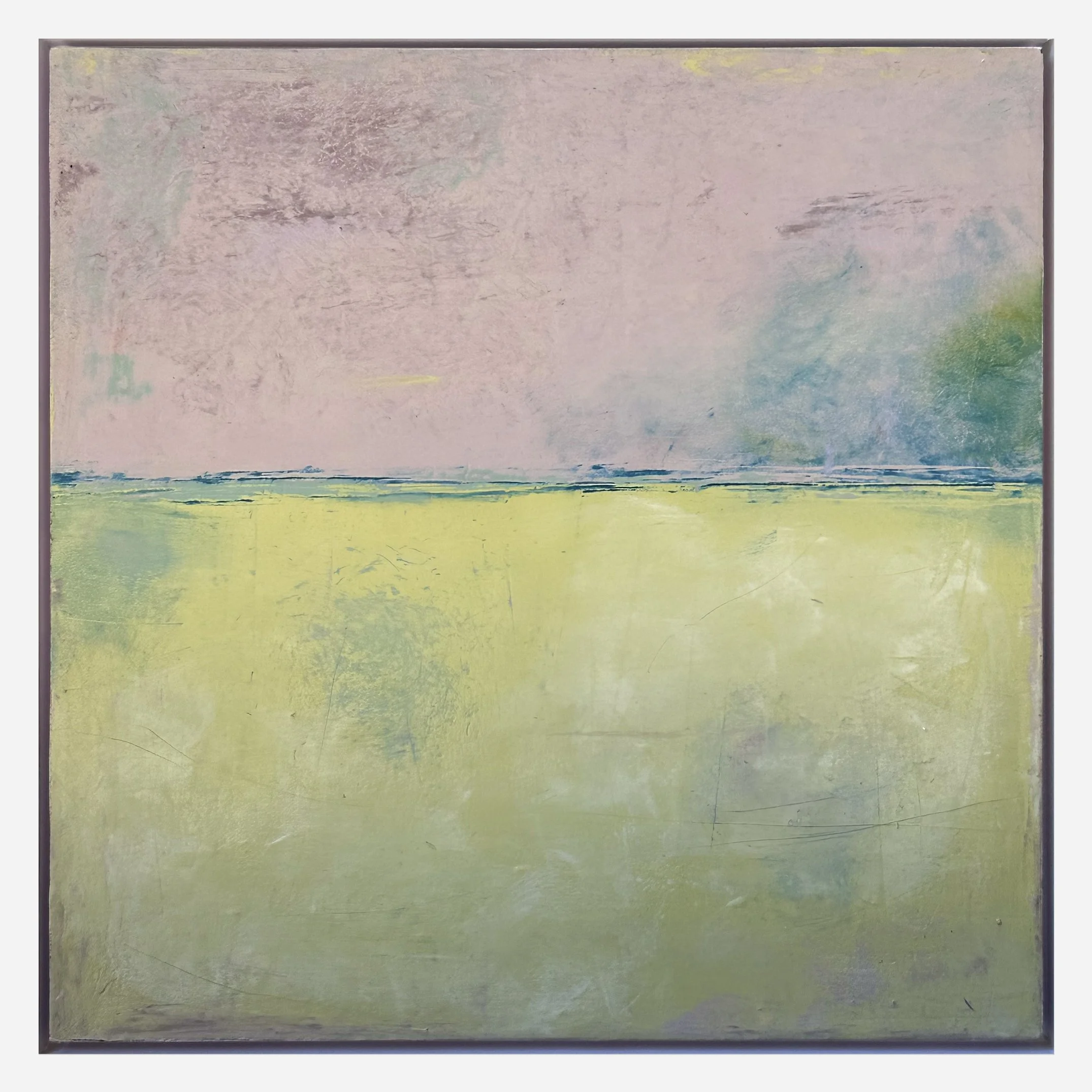Featured Works
by Full Moon Artists
© 2024 Full Moon Arts Collective
Suffolk County Court House by Mike McLaughlin (after and before edit), 2024, Photographs
“Photoshop has a bad rap. It’s often associated with altering images to an unrealistic degree, sometimes with disingenuous results or even nefarious intent. However, when wielded responsibly Photoshop has the potential to enhance and highlight the intrinsic beauty of the real world. By using it as a tool that complements the creative process it can enhance visual narratives while staying true to the essence of the captured moment.
The Suffolk County Court House in downtown Riverhead is a beautiful and imposing example of Greek Revival architecture. For years I’ve admired the building while lamenting the existence of the multitude of utility wires that obscure it. Finally I bit the bullet and went to work in Photoshop on a recent photo I took of the structure. It’s a tedious process but, as a technically-based photographer, something that I can sink my teeth into and find pleasure in. My reward was a first-ever unobstructed view of one of the most beautiful classical buildings on the East End.”
Bingo by Jonathan Pearlman, 2024, 20” x 7” x 13”
“There is not much to say about this piece other than it amuses the eye and engages the mind. It’s not about big ideas. It’s about fun - fun to look at and most importantly, fun to make.
Art does not have to be so serious all the time. Leave room for serendipity - it often allows for life to seep into what you are working on.”
A Door in the Woods #9 by Gina Gilmour, 70” x 80”, oil on canvas
“This is the final painting in a series of nine paintings called ”A Door in the Woods”, in which I follow a painter through stages in the process of making a work of art.”
The Deleted Chapters by Jane Kirkwood, 2023, 15” x 14”, cold wax and oil paint on wood panels
“The Deleted Chapters is a compilation of four 5x7 birchwood panels.
The medium used is cold wax and oil. Cold wax is basically beeswax dissolved into a solvent which is then mixed with oil paint to provide a rich matte surface.
I allowed the images to just pop out of my head intuitively. Where they came from and what they mean, I can’t say.
I did enjoy the buttery-ness of working with the cold wax medium.”
The Three Graces by Steve Palumbo, 2023, 36” x 36”, oil on canvas
“In the late 1970’s I attended the opening of a Jack Levine exhibit at the Jewish Museum. I had become friendly with Jack the year before and frequently visited his studio on Morton Street in Greenwich Village. I learned a great deal about painting (and about life) from him. One of the paintings in the exhibit was “The Three Graces”, which he had completed in the mid 60’s. It was oversized and gorgeous, maybe 6 feet square with giant whorls of flesh and tangled arms and legs filling the space; figures that were voluptuous and Rubenesque. I have rarely been as affected by an artwork as I was that night.
My oil painting of the Graces is a tribute to Jack. It is done within a grid of circles - a method I have recently been working with. To the Greeks the circle was a symbol of divine symmetry and perfect balance.
The Three Graces were the daughters of Zeus, each of which was purportedly able to offer a particular gift to humanity.”
I Think I’m a Duck by Jonathan Pearlman, 2023, 20” x 6” x 14”
“I think it’s a duck. At least it looks like a duck.
100 years ago it was a car horn with a rubber ball attached to one end. Squeeze the ball, honk the horn. But now, add a wooden ball and an old clothespin and it becomes a duck. Lucky you who hears a duck. Honk! Honk! Honk!”
Endless Journey by Giampaolo Fallai (base) and Anna Jurinich (head), 2023, 12” x 4”, spalted maple, acrylic paint
“I created “Endless Journey” with a lathe from a solid piece of spalted maple.
Back in the days when I was attending the Leonardo Da Vinci vocational school in Florence this intricate piece was part of the school’s final exam. Each student was given an identical piece of metal (usually aluminum) and a picture of what we were supposed to make out of it; no drawings, no blueprints, no hints. This particular piece was called “L’incubo del Tornitore” (Machinist’s Nightmare) and for good reason! It was very difficult to execute, involving math, geometry, trigonometry, and a lot of thinking outside the box. We had only six hours to complete it and I’m happy to say that I was among the 25% of students who passed the test.
Back in the States and after 50+ years I decided to test my skills again to see if age had taken a toll. I was surprised when it all came back to me – memory and skills were intact, it just took longer!
I motorized it in a way that it will rotate in both directions, but it didn’t feel finished. I decided to seek the help of my artist wife Anna. She painted a sphere with three different faces and placed it on top. Now when the piece is rotating it’s giving the impression of an endless journey.”
Kitty and Norah, or The Quadriga by Peter Beston, 2020, 38” x 28”, oil on canvas
““Kitty and Norah, or the Quadriga” is the second in my painting series “Statues”. As with the first of the series, this picture points to the differences between actual people and the idealized concepts embodied in heroic sculpture.
Again, I’m looking at both ends of a very wide spectrum; Kitty and Norah were my aunts, both strong, sensible people, though entirely different in character. They reached maturity during the Thirties and lived through the London blitz, listening to the bombs dropping on either side of their home.
The sculpture of the winged victory represents victory in warfare, a female figure leading a war chariot, created by a man (why a female when wars are always fought and won by men?), gigantic, glorious, powerful, and inspirational in a certain sense.
To illuminate the differences between actual women and a symbolic representation of a woman, the aunts are not that impressed with the statue. They use the plinth merely as a vantage point from which to observe something out of frame that is far more interesting than the figure behind them.
Their fearlessness and strength are suggested by the unknowable height of their perch. Later they will enjoy the picnic Norah is carrying in her basket!”
Earthly Flowers and Alien Silver by Anna Jurinich, 2023, 26” x 34”, acrylic on paper
“When you start working, everybody is in your studio – your friends, enemies, the art world and above all your ideas. But as you continue painting, they start leaving and you are left all alone. Then if you’re lucky, even you leave.
— John Cage
When I was painting Earthly Flowers and Alien Silver I think I was that kind of lucky. It felt like the painting painted itself.
It represents our future collaboration with other entities in the universe who have the best intentions towards us, and share with us their superior silver.”
Hidden Messages by Valerie Zeman, 30” x 27, silk broadcloth, silk sheer organza, dye
““Hidden Messages” is a contemporary layered art-textile with a base substrate of silk broadcloth with numerous 4” square monotypes made with black thickened dye and asemic writing scratched into each monotype. The next layer is hand-dyed silk sheer organza which is fused to the substrate. This work was inspired by text and writing whether asemic or actual letters.
My art gives me a space to communicate what is visually around me as well as the thoughts and feelings deep inside myself. I feel the inclusion of forms of writing and text allows me to not just communicate with viewers but with my internal self and what I am trying to convey through my art.”
Tom by Jonathan Pearlman (sculpture) and Steve Palumbo (paper plumage)
“Tom made his first appearance several years ago when I bought an old abacus at a yard sale. I was attracted to the large wooden balls, all 30 of them. They were painted blue, green, red, pink and yellow. Chipped and faded they looked like they had been around for a hundred years. Following my general rule of thumb that anything that has been around longer than me is worth keeping, I took the abacus home, removed the splendid beads, and set them aside for future use.
A year or more later I threaded the balls to two steel rods, attached two wheels from a child’s toy wagon and then they sat for a while in the corner of my studio looking like two legs waiting for the right body to appear. Another year or so passed before a large globe found its way to the studio. The globe had some age as well, as Rhodesia was still noted as a country on the African continent. To my mind the legs and globe formed a perfect match and with a little luck I found an old noise maker from the forties that formed a perfect face…and Tom appeared. But Tom was not complete. I had painted the globe white, his shape was fine, materials to my liking, size appropriate but alas, little personality. So, it again sat in the corner, waiting as they say for lightening to strike. Lightening arrived in the shape and form of my friend Steve Palumbo, a master in the craft of turning paper into art.
“I am not happy with my turkey,” I said, “something is missing.” Steve simply said. “Let me take a crack at it.” Two weeks later Steve returned with Tom fully realized. He used paper color paint chips to create the plumage. A brilliant idea beautifully realized.
So, a lesson learned: When in trouble always call Steve Palumbo, and the answer to two often-asked questions: where do you find your stuff? The answer is always everywhere, and how long does it take to make a piece? The answer is sometimes years.”
John Jermain Memorial Library by Mike McLaughlin, 2022, photograph
“In some ways my path in photography has been circular. Although a longtime resident of Manhattan I didn’t pick up a camera until I began spending time on the North Fork of Long Island. As my technique developed it became evident to me that while my subject matter was rural in nature the hallmarks of my style reflected my love of the simple, clean lines of modernist architecture.
Only later did I actually turn my lens toward the built environment of New York City. Wide cityscapes evolved into studies of individual buildings which further evolved into a series of “Architectural Extractions” – where cluttered city backgrounds are replaced with solid color in order to focus attention on a structure’s form and ornament. This process in turn was later applied with similar effect to local landmarks back on the North and South Forks, thus giving rise to “East End Extractions”.
John Jermain Memorial Library is a part of this series and also the Sag Harbor venue for a Fall 2022 Full Moon exhibit.”
Like the Deer that Yearns… by Elizabeth Malunowicz, 2022, 12” x 12”, painting on archival board
“I painted this deer from a photograph that a friend of mine took. I love the look of innocence and purity in his eyes.
On the North Fork of Long Island deer are our neighbors. I’ve watched the adults grazing on lawns as their young ones romp and play together. When I lived in Orient I witnessed the daily routine of a family walking down to the bay in the morning and returning back into the woods in the evening. I admire their resilience and grace.
Many people feel the deer are a nuisance – eating plants or jumping out onto the road. It saddens me to see a dead deer on the street or in the back of a truck after being hunted. Yet their simple lives and beauty remind me of our own fragility hidden beneath our public facade.
The photographer – my dear friend – recently passed and this “deer that yearns for running streams” from Psalm 42 reminds me to pray for him to “enter and see the face of God.””
Ivory for Sale by Janet Culbertson, 22” x 30”, acrylic and collage on rag paper
“I saw elephants in Africa and greatly admired their magnificent power and sensitivity. One picked up a wallet a tourist had dropped and returned it to him. We saw them swimming in the lake, buoyant and joyous. Upon crawling out they powdered themselves with pink sand. (This gave me the idea for my large drawing entitled Little Pink.)
For greed and stupidity tusks are valued as ornaments; elephants slaughtered and their infant offspring orphaned. The billboard - that great America icon - urges us to consume and devour our resources and creatures.
I have devoted my art to the climate crisis, depicting many of the horrors occurring on our planet. Does it help? I don’t know. But I feel as a witness in paint I am trying to help bring attention to the problems.”
The Blessing of the Unicorn, or Medieval Theme with Cadillac, by Robert Moore
“Sometimes I can’t bring myself to finish what I set out to do and the entire effort becomes an obsession. Like this piece which I’ve been working on intermittently for the last couple of years. It’s titled “Medieval Theme with a Cadillac”, or maybe “The Blessing of the Unicorn”. I’ll decide on this at a later point.
It’s the last of my interpretations of the Medieval French Unicorn Tapestries. It’s constructed like a traditional medieval tapestry with the action occurring within a floral and foliage border. But while the French tapestries illustrated violence (you can see this theme reflected in my earlier unicorn work in this gallery) this new one is loving.
And I jammed a lot of love into this: the crows who represent friends I’ve lost, the slithery and creepy-crawly forest creatures who never get enough respect, the unicorn who was mercilessly hunted in the original medieval tapestries, the floating spheres of the souls of soldiers lost at war. Jesus drives up in his time-traveling Cadillac and blesses them all. He is the Christian symbol for love, sacrifice, and forgiveness, and he walked this earth. Now he drives a vintage luxury car.
This image that I’ve made in my computer will eventually be assembled in pieces on a 45” x 60” canvas. I’ll print it on Japanese gampi paper because it’s absorbent and has worked well with my encaustic efforts. I’m now choosing to use acrylic medium because it’s flexible and will enable me to work large scale on a stretched canvas. (The encaustic medium on the other hand cracks when flexed and requires a rigid board underneath.) Steve Palumbo and Jane Kirkwood have been giving me pointers on working with acrylic medium and maybe I’ll add some acrylic paint over the assembled piece.
About Saturn… I put it in because it’s perfect and beautiful and had to be there.”
Chelsea by Valerie Zeman, 33” x 36”, hand-dyed silk and cotton, photo transfer, screen printing, monoprinting, hand-stitching, burned edges
““Chelsea” is created with fabric and photos I took of buildings, walls, doors, signs and streets in the Chelsea neighborhood of Manhattan. Layering is a key component of my work and this piece starts with silk that has been monoprinted. I then printed my images on silk organza and fused them to the first layer before screen printing was added as another layer. Hand stitching with hand dyed threads was the final layer and the most meditative of the processes.”
Last Winter in Hauptbahnhof by Jane Kirkwood, 2021, 8” x 8”, encaustic on wood
“I’ve been dabbling with encaustics for the past few months in hopes of encouraging my art to become a bit looser and freer than I seem capable of doing when working with classic oils in figurative style. I’ve always admired the lovely ‘atmospherics’ achieved by artists working with wax. I’m still surprised by how difficult the media is to master but am enticed by its enormous versatility.
”Last Winter in Hauptbahnhof” is created with a collage of various subway images and a single figure transfer on different encaustic layers adhered to a raw wood board.”
Sommelier by Jonathan Pearlman, 2014, 28” high
“Some years ago I had the great pleasure of walking from 7th Avenue and 55th Street in Manhattan to Madison Avenue and 43rd Street with the great cartoonist Chuck Jones (Bugs Bunny). He had the amazing ability to see the animal that most resembled a person passing by. “Look a zebra,” he’d say, and sure enough a zebra appeared to my left. Then a bear, a skunk, an elephant. It was quite hilarious and a walk I will never forget.
Find one thing that may be true and build on that.
“Look Chuck…a violin.”
Lady in the Hat by Ronnie Wiener, 20” x 16”, acrylic on canvas
“While the imagery is symbolic, it is also personal. The owl, as a symbol of wisdom, visual clarity, and comfort in the night, sits on the woman’s shoulder as if they’re a twosome. And they are. She is beautiful but clearly something is not whole, yet she is the sturdy perch for the owl. The Owl is focused ahead of them while she gazes at her reflection in the water. The pathway looks treacherous and beautiful and it will be the owl who guides their path.
I used three canvases as an indication of change and of getting past the static of being confined in a frame.”
The Immortal Cells of Henrietta Lacks by Steve Palumbo, 12” x 12” each, colored pencil, pastel, newsprint & oil stick on wood panel
“This grouping is titled “The Immortal Cells of Henrietta Lacks”. Each 12” x 12”panel is composed of a group of stained cells rendered in colored pencil, pastel, newsprint and oil stick on wood panel. It is an homage to Henrietta Lacks, a poor African-American woman whose cervical cancer cells were the only ones to replicate indefinitely in cultures at the labs of Johns Hopkins Hospital in Baltimore during the early 1950’s.
These amazing cells — nicknamed “HeLa” cells, from the first two letters of her first and last names — have been used to study the effects of drugs, neurotoxins, hormones and viruses on the growth of cancer cells without experimenting on humans. They have been used to test the effects of radiation and poisons, in ongoing studies of the human genome, and to learn more about how viruses work. They also played a crucial role in the development of the polio vaccine.
Although Mrs. Lacks ultimately passed away on October 4th, 1951 at the age of 31 her cells continue to impact the world.”
My Mother’s Bowl by Elizabeth Malunowicz, 24” x 24”, oil on canvas
“Simple bowls are my favorite objects to paint. They can hold so much – a memory, belief, question, or commentary. They can be plain or elaborate and have been around for centuries. We eat from them, beg with them, celebrate with them, clean with them, share memories or create new ones over them.
“My Mother’s Bowl” was painted with love after my mom passed away. We kept the colored bowl set when we moved her out of her home. They were filled with memories of Sunday dinners I had when I was young. In the summer my mom would make coleslaw and fill the yellow bowl with it. As we sat at the kitchen table I would watch her slice a whole cabbage by hand as I cut the potatoes for the potato salad that would fill the smaller green bowl. It was truly a labor of love. On winter Sundays she would fill the yellow bowl with spaghetti and meatballs, or a freshly made pot roast surrounded by noodles and swimming in a savory sauce. There were seven of us in the family yet the bowl always held enough for everyone, including guests.
The faded wallpaper in the background of the painting was originally bright orange, yellow and green. It filled the upper part of the kitchen walls where many family meals were shared.
In this difficult time that we have all been struggling through I hope this painting can remind us to cherish our loved ones as we begin again to gather around a table to share a meal and a moment of joy.”
World Trade Center (l.) & 55 Hudson Yards (r.) by Mike McLaughlin, 2020, photography
“In my Architectural Extractions series processing techniques are used to highlight the beauty of notable buildings in urban environments. By removing and replacing the often cluttered surroundings the viewer is encouraged to focus on the details of form and ornament. The replacement solid or gradated color brings a new context to the structures – perhaps suggesting the building’s “personality” or accentuating the quality of light.”
Embraces, video by Gina Gilmour (click to play)
“This video shows my linoleum prints, drawings, embroideries, and sculptures on the theme of the Embrace. The series was initially begun in response to the grief created by the losses of 9/11. I have returned to this theme with new images during this year of the pandemic when so many embraces have had to be withheld and postponed.”
Bouquets of a Lifetime by Anna Jurinich, 2020, 30” x 40”, oil on canvas
“Bouquets of a Lifetime deals with the passage of time and how we often seem unaware of its speed. While painting, it seemed almost like I could not stop adding more and more flowers — as if there would never be enough.
Ultimately my aim through the intensity and detail was to lead the eye through the bouquet, and at the same time perhaps bring about a reexamination of the viewer’s own life and remembrances of moments of beauty in it.”
I saw a Crocus Painted Blue, Poem by Vito Gentile
“For me, this very simple poem captures the anticipation and joy of an imminent spring.
I have been writing spring poems for the best part of fifty years, and most have been written, or at least conceived, on park benches. I have always had a great fondness for parks, with their majestic trees, ponds, and flowering borders. There’s no better place than a park for writing a spring poem.
The parks that have inspired me most are Prospect Park in Brooklyn, where I spent my adolescence, Washington Square Park in Manhattan, where I spent my so-called formative years, and Regents Park in London, where I believe I finally ripened!
Now all the poems are collected in a volume entitled Fifty Poems About Spring.”
The Wave by Giampaolo Fallai, 2020, 7” x 12” x 3”, oak, maple, epoxy & plexiglass,
“The inspiration for The Wave came to me as I was looking at a particularly interesting piece of highly figured oak; it reminded me of the sea. As I layered clear epoxy onto the wood The Wave took on a new shape. As I sliced it in several sections and mounted the sections on plexiglass pegs it became more and more real. By the time I was finished The Wave was alive and in perpetual motion.”
Jessup Sanctuary by Janet Culbertson, 24” x 36”, acrylic and sand on canvas
“This is one of a series of East End landscapes I painted in the 70’s. As an eco artist for over 50 years, I paint the Earth’s diverse creatures and landscapes, exploring their beauty and demise. The majority of my works deal with the environmental crisis, prompted by the devastating news of the day. But I never lose sight of the beauty that still exists, albeit precariously.”
Sonia Haardt, or France de la Renaissance by Peter Beston, 2020, 38” x 28”, oil on canvas
“What does it mean to be human? A big question. Perhaps too big to express in a single work of art, like a painting. An easy answer might be that we embody a multitude of characteristics – both as individuals and as a species. In the painting “Sonia Haardt, or France de la Renaissance”, I’m looking at both ends of a very wide spectrum, at the microcosm and macrocosm of this huge subject.
Sonia the person represents the biological, emotional, flesh and bone aspect of human-ness. She is self-absorbed, introspective, thinking perhaps of an imminent assignation, or about something quite inconsequential. She enjoys having fine tactile accessories about her person – silk, gold, fur. She enjoys the sensuous sensations they evoke.
France de la Renaissance is a huge work of art, both as an allegory and literally; a sculpture that represents all the achievements in human thought, philosophy, science and art that arose during that far-reaching cultural revolution. The figure of France has her eyes fixed on some vast distant horizon, taking in and knowing every aspect of that great period in French history.
Why “or” and not “and” in the title of the painting? For me “and” conflates the two subjects too easily for the purposes depicted here - “or” points to the differences in the aspects of humanity embodied in the person, and the statue.
Of course, “and” is equally valid, because despite the apparent differences highlighted in the painting, in some ways it is a picture with a single subject.”
The Cheetah’s Dream by Ronnie Wiener, 2020, oil on canvas board
“The symbolic nature of life is a long founded curiosity of mine. So much of what we say and do has a contextual thread beyond the apparent. It is that part of life in art and connectivity that interests me. I love the play of the the dream in our thoughts. I enjoy paying attention to the coding and mapping that the dream offers. The story that goes beyond the individual, the one that connects to the other thru a commonality of experience.
Expressing myself thru art is a fairly recent venture of mine. When my husband and I started spending most of our time here about 15 years ago we were both entering a new space in our lives, both figuratively and tangibly. We knew he was ill with an illness that would take its toll over a certain number of years. Luckily for both of us he did not experience any pain and we were able to enjoy our limited life together. During that period I started to construct spaces that I called sanctuaries. I built other spaces using found materials from others lives and incorporated them into stories of mine. He passed away about 12 years ago.
During that time I reflected on the light and the dark as a symbolic theme. The light of the moon is of particular interest to me. The Buddhists say that when you’ve lived to be 80 you’ve experienced 1000 full moons which represents having led a full life. We celebrated my husband’s 84th birthday.
A few years ago I had a dream about the dark side of the moon being bejeweled and filled with prismatic light. I wanted to paint that symbol and asked a friend for the name of a teacher who could teach me how to paint. He recommended Anna Jurinich a local established painter. We began our lessons together. The first time I was able to express myself thru painting was like opening a garden door of imagination. It is not always easy and we continue to work but painting offers a lesson in symbolic connectivity that is optimistic and challenging at the same time.
The source of the cheetah painting is my 6 year old grandson who was given that identity when he began kindergarten. I always encourage him to talk about his dreams with me. This painting is about that Cheetah confronting the challenges of his environment and imagining himself as well in a boundless leap as high as the moon as he plays with his paws.”
Wire Walker by Jonathan Pearlman, 2012
“I knew a wire walker who put his life on the line every time he stepped on the wire.
”But what if you fall,” I asked?
”I cannot fall,” he said. “I am a wire walker.”
The Process
A walk on the beach. I happen upon a number of Skate eggs at the high-water mark tangled in a mess of seaweed. Later I take them from my pocket and deposit them on my worktable alongside a thousand other found or collected objects. Then I go to bed. The next morning in my studio a number of objects grab my attention and my job is to discard the ones that do not go together. If one object fits with another it is often the beginning of a story and my job is to finish the story. If it is the beginning of a whimsy or a joke, mine is to deliver the punchline. It is very much a collaboration between the object and me.
Art is a mysterious thing — I don’t want to take the magic out of it.
”Wire Walker” was made in 2012 during more optimistic times using objects found on the East End of Long Island: Skate Egg, Barrel Slate, Wire, Ball, Pick-up Stick”
Invictus by Steve Palumbo, 2017, 36” x 36”, torn paper on canvas
“I did this piece in late 2017 after my brother-in-law, Ray Plakstis, had been diagnosed with a rare 9/11 related cancer. Ray was a firefighter and had responded on that day, and survived. But one of his closest friends, also a firefighter, did not. Ray spent the next 9 months digging through the Trade Center pile every night until the body of his friend was recovered.
Like everything he did he approached his illness and treatment with strength and grace, and the unmitigated belief that he would conquer this disease. Ray reminded me during those difficult months of one of my favorite childhood poems by William Ernest Henley, ‘Invictus’, which includes the lines:
In the fell clutch of circumstance
I have not winced, nor cried aloud
Under the bludgeonings of chance
My head is bloody, but unbowed
I had an image in mind of a battered boxer waiting for the next round, still in the fight, head unbowed. I gave the finished piece to Ray in January of 2018. He hung it on the bedroom wall of his home in Florida where it remains today. Ray died on November 30, 2018 and received a line-of-duty firefighter’s burial in Great Neck, New York.”
Untitled #1 by Robert Moore, 2018, 52” x 52”, multi-panel encaustic print assembly
“A few years ago, over one summer, I photographed polo ponies at a polo horse ranch close to my home. I had a specific idea for a series, but, as it turned out, the ponies all had their manes cut close to the skin like military crewcuts. So I decided to change the direction of my idea by transforming the ponies into unicorns with floral manes, and place them into new compositions based on the Medieval French unicorn tapestries. Also influencing my concept were pop artist James Rosenquist’s large-scale Vietnam war era painting, F-111 as well as Renaissance paintings of Saint Sebastian, the Christian martyr, who was tied to a tree and impaled with Roman arrows.
The French tapestries show the unicorn being hunted, brutalized with spears, and captured. Scholars believe the tapestries depict the last period of Christ’s life (The Passion of Christ). I see the tapestries differently. I believe they reflect man’s desire to dominate the natural world. In my composition I preserve the original, violent assault on the unicorn, but use it as a backdrop for a contemporary phenomenon, equally threatening to nature and stewardship of Earth. I represent this by a trio from the 21st Century, so gleefully self-absorbed in the foreground that the beautiful, wounded creature behind them can’t distract from their clueless amusements. It’s my aim to emphasize this state of denial and illusion in a way that references Rosenquist’s juxtaposition of realistic images of war next to brightly-colored pop-art depictions of magazine consumer items.
The question I keep asking myself: are the people in my composition disinterested selfie-takers or, more venally, are they posing in front of their hunting trophy?”
Remember, 3rd in series by Elizabeth Malunowicz, 12” x 12”, oil on archival panel
“A series of work inspired by my intention to keep a memory of a moment alive, and to pay homage to that which stirs the soul and frees the mind.
Floating in a thin place,
On a sacred horizon.
Songs of birds and soft waves.
Salty water as a healing balm,
Given as a gift to remember.”
Francesca at the Window by Jane Kirkwood (in private collection)
“Francesca Ricardo is my neighbors’ granddaughter. Every summer she visits them at their beach house in Riverhead.
Even as a 9 years old her eyes hinted at the underlying sorrow she lived with knowing her brother Christopher was fighting life threatening Cystic Fibrosis Disease. The same year Francesca traveled to Washington DC to address congress with her personal appeal to expand federal funding to find a cure for the disease on behalf of all CF victims .
In this painting I attempted to capture Francesca’s courage, her intrepid spirit and her kindness.”
Abrasha in Port-au-Prince by Peter Beston
“Abrasha was a friend of my grandfather’s, who took a photo of him in 1923 in a London square. On looking through old family photos I came across the picture, and the pose and challenging expression made me want to paint him. I transposed his surroundings to Port-au-Prince in Haiti as I thought the figure would work well in a hot, Carribean-style setting. My intention was to capture the viewer’s attention with Abrasha’s enigmatic expression, and in that the slightly mysterious setting, to pose questions about what exactly he was thinking. The finished painting won an Award of Merit at the Heckscher Museum of Art’s 2018 Biennial exhibition.”
“HONORING THE HEALTH WORKER
Despite his scary outfit, the Plague Doctor was the person sent to comfort and attempt to cure the victims of Bubonic Plague. His willingness to perform such a depressing and dangerous job (which included confirming deaths and arranging for disposition of the deceased) was nothing less than heroic, just as our amazing nurses and doctors are risking their lives to help save victims of Covid-19 today. ”
Past Landing Page Images
Briermere Farm by Mike McLaughlin, Photograph, 2015
New Land by Gina Gilmour, 84” x 112”, Oil on Canvas
The Art of Conflict by Peter Beston, 48” x 96”, Oil on Canvas
The Good Earth by Jane Kirkwood, 2020, 24” x 30”, oil on canvas
Deep Circle by Robert Moore, encaustic process print on gampi paper
Just Picked for You by Anna Jurinich, 2021, 26” x 32”, acrylic on paper
Another Sunrise by Janet Culbertson, 2021, 36” x 48”, acrylic on canvas
Never Alone by Elizabeth Malunowitz, 12” x 12”, oil on archival board
Snow Town by Steve Palumbo, 2020, 12” x 12”, paper and acrylic on board
Winter Pines by Mike McLaughlin, 2018, photograph
Billboard by Peter Beston, 2022, 16” x 36”, oil on canvas
Stay by Anna Jurinich, 2022, 24” x 24”, acrylic on canvas
Pop’s Pipe by Jonathan Pearlman, 2012, 14” x 12”, mixed media
Indigo Moons by Valerie Zeman, 2022, 30” x 51”, natural cotton, silk broadcloth and silk organza manipulated using age-old Japanese shibori methods and dyed in organic indigo vat
The Cardinal Tree by Gina Gilmour, 52” x 60”, oil on canvas
Eve by Steve Palumbo, 2022, 28” x 36”, oil on cardboard
Exit Wound by Janet Culbertson, 52” x 72”, oil and iridescent pigments on rag paper with collage
Ascophyllum Nosdosum #1 by Jane Kirkwood, 2023, 12” x 12”; beeswax, pigmented shellac, ceracolor wax paint on birch panel
Forsythia by Elizabeth Malunowicz, 2022, 10” x 10”, oil on prepared paper, mounted on wood
The Back of Sherman & The Back of Liberty by Mike McLaughlin, 2023, Photographs
Late Summer by Valerie Zeman, oil and cold wax painting, 12” x 12”, 2023
Paris Air by Peter Beston, 2015, 36” x 60”, oil on canvas
Hopeful Refugee, Hopeless Journey by Anna Jurinich, 2018, 39” x 40”, acrylic on canvas
Balance by Elizabeth Malunowicz, 2018, 36” x 48”, oil on canvas
